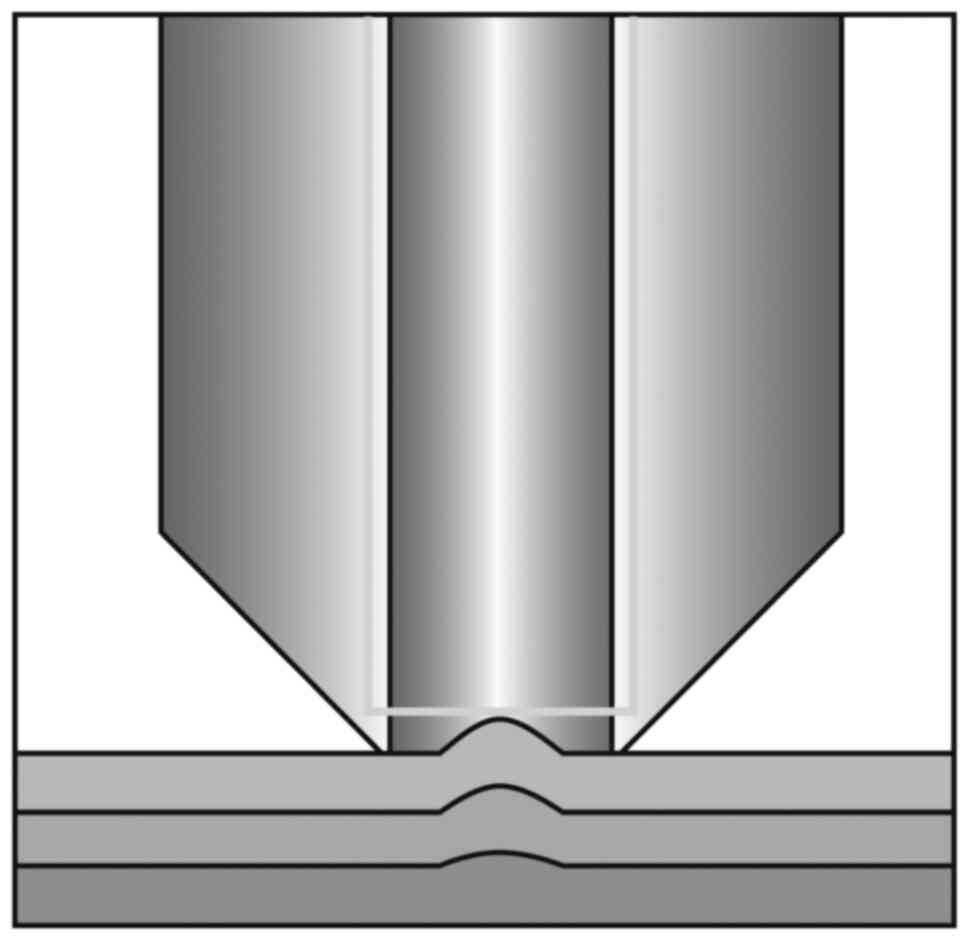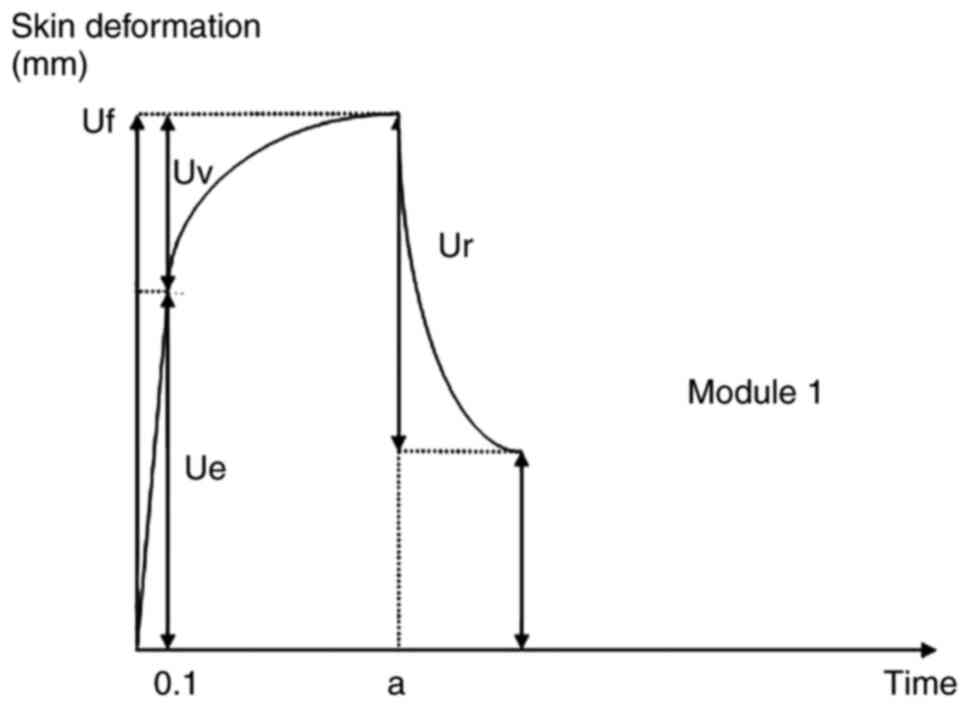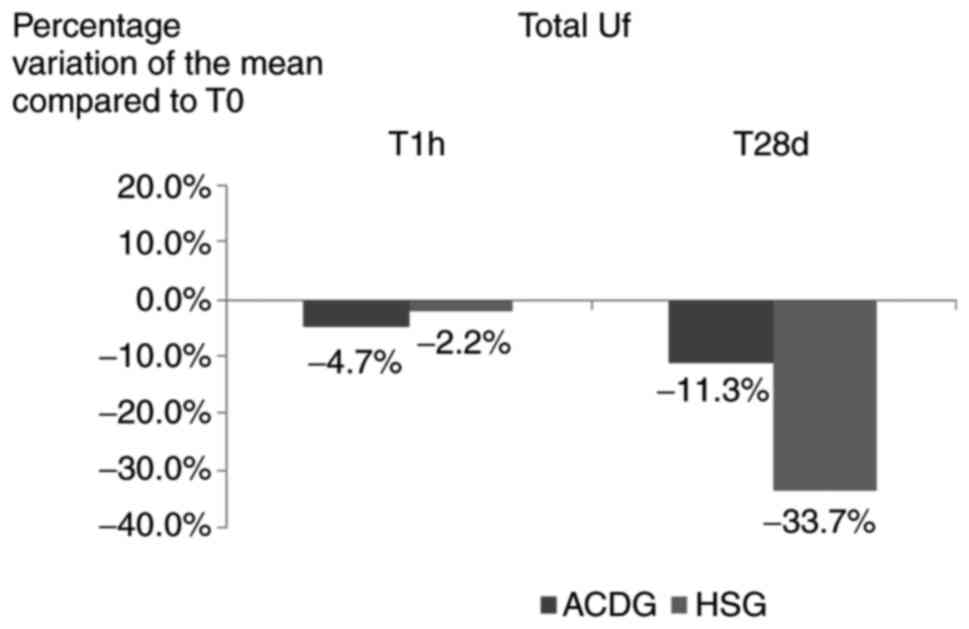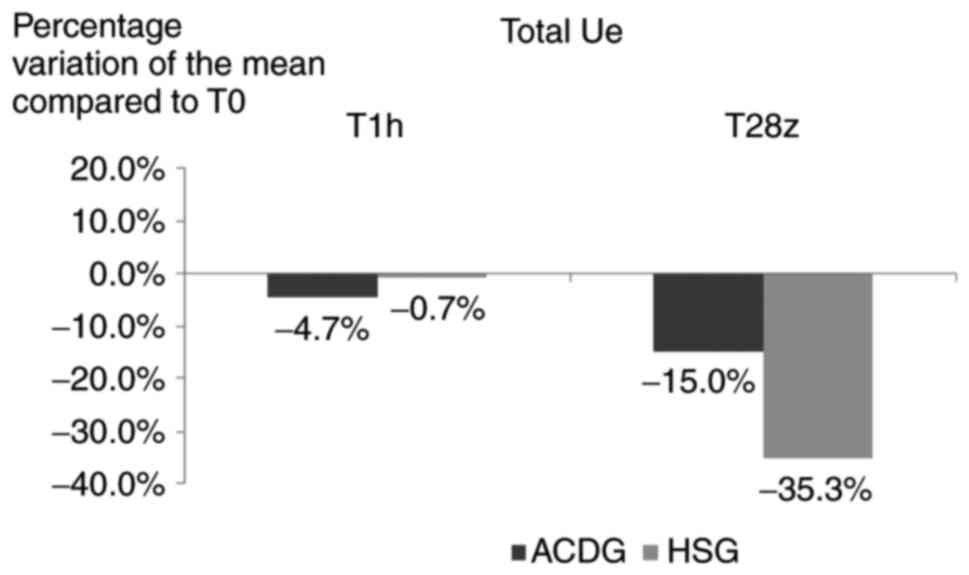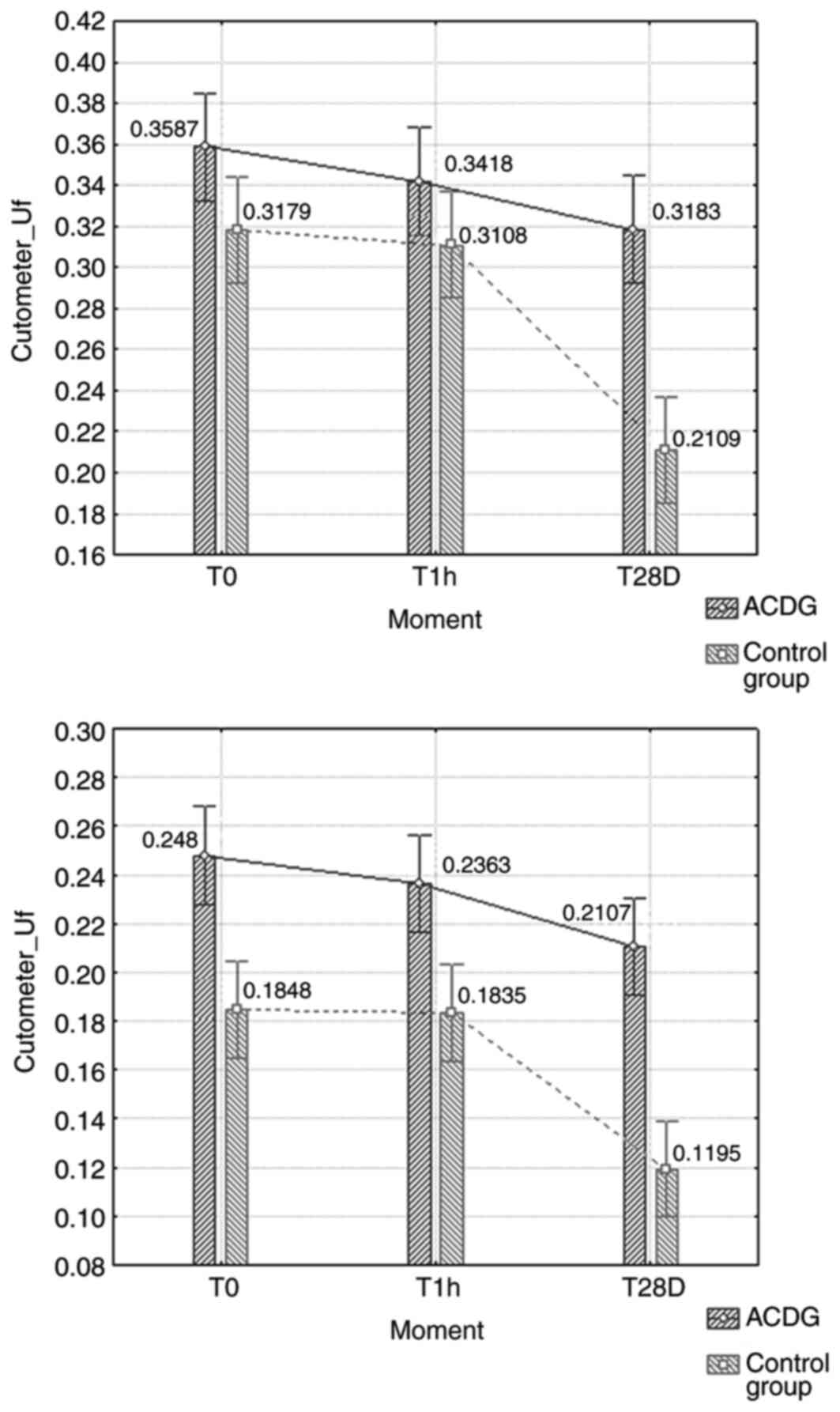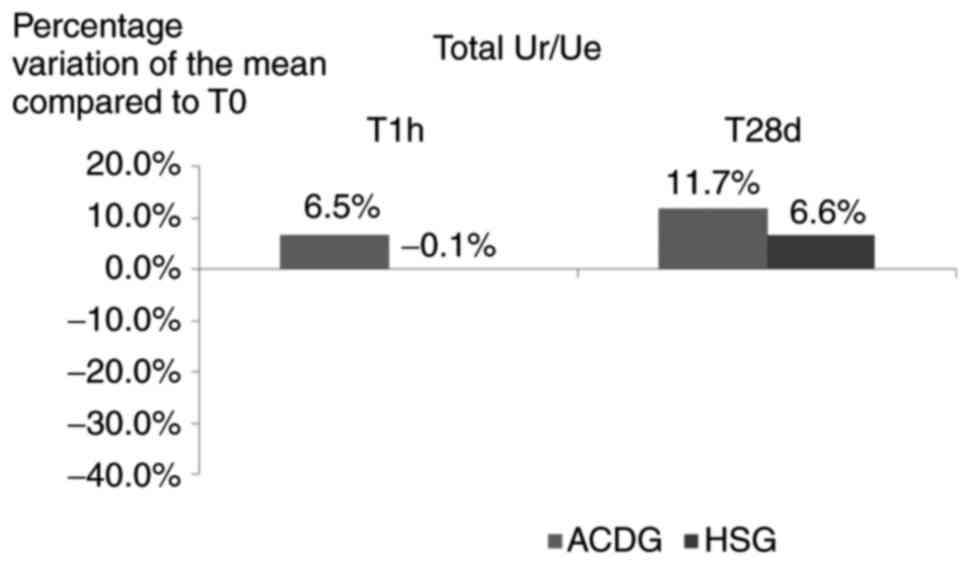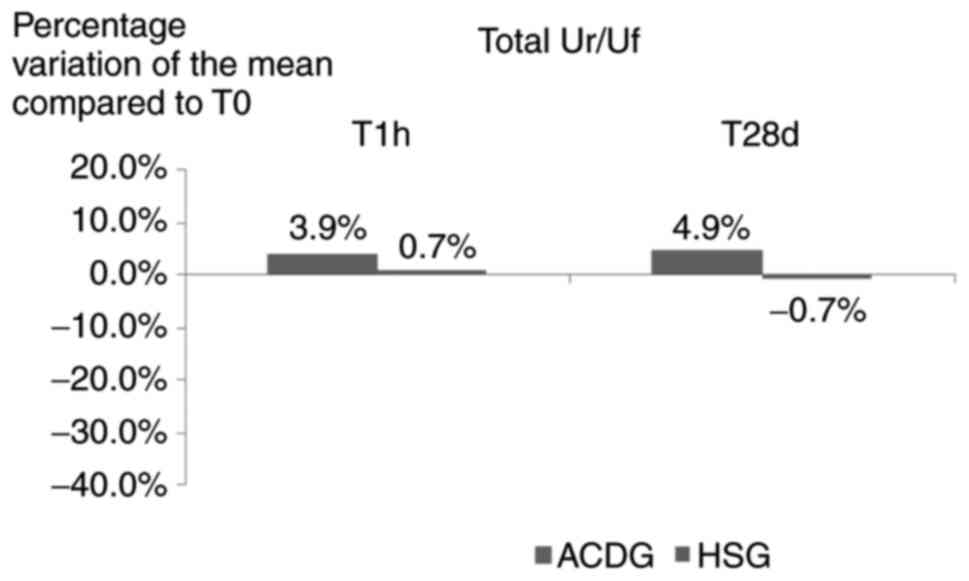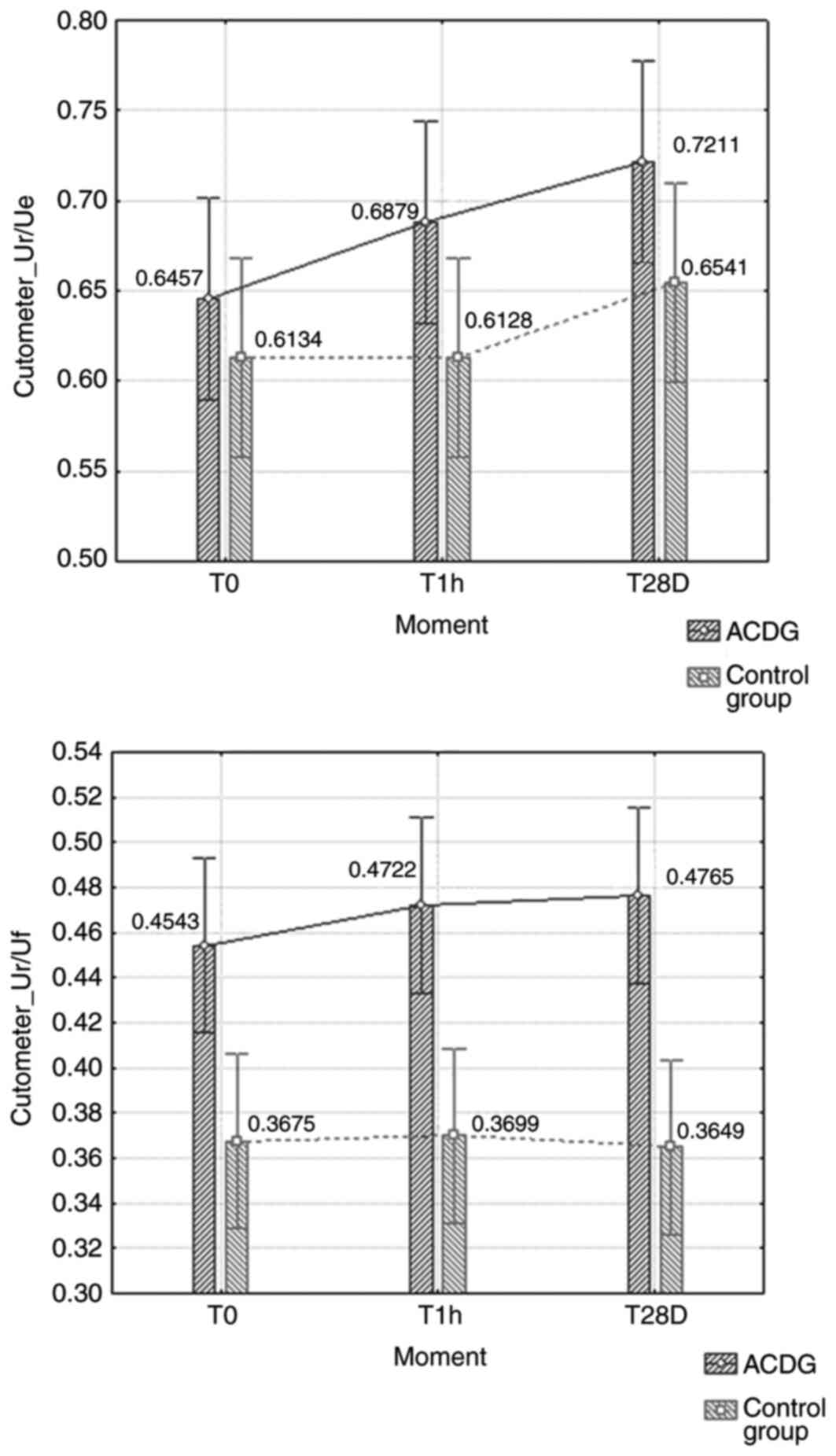Introduction
The mechanical properties of the human skin have
been studied in the past proving that elasticity is a dynamic
function (1). More precisely, it
has the properties of both elastic solids and viscous liquids
(2).
Non-invasive bioengineering technologies are
constantly being developed with the potential of offering new
mechanistic insights. The Cutometer® (Courage+Khazaka
Electronic GmbH) has been introduced as a device that can measure
the viscoelastic properties of the skin in vivo. It provides
information on physiological and pathological changes of human skin
as well as the efficacy of topical treatment.
The present study assessed the viscoelasticity of
the skin in a group of patients with chronic allergic contact
dermatitis vs. a control group of healthy individuals. Assessment
was performed after applying a moisturizer to both groups,
demonstrating the effectiveness of this moisturizer for both
healthy and unhealthy skin.
Patients and methods
This was a prospective controlled study over a
period of 3 years (March 2016-March 2019), on a group of patients
diagnosed with allergic contact dermatitis, the chronic type, with
recurrent episodes (ACDG) and on healthy subjects (HSG). All the
subjects signed an informed consent form. The inclusion criteria
were: Age between 18 and 70 years with no previous treatment;
allergic condition confirmed by the previous positive epicutaneous
tests for specific allergens (patch-testing) for ACDG specifically
(3). The exclusion criteria were:
Known history of allergy to ingredients included in the testing
cream; other diagnosed skin diseases (4,5);
malignant skin tumors in the last 5 years (6,7);
recent vaccinations, 2 weeks before starting the study or the
intention of vaccination during the study; recent dermato-cosmetic
or esthetic treatments, 2 months before the onset of the study
(dermabrasion, peeling, laser therapy, IPL, botulinum toxin
injections or fillers); recent and intense exposure (1 month before
the study) to ultraviolet radiation (sun/tanning salon); pregnancy
of intention of pregnancy; inability to follow protocol for any
reason.
A total of 81 individuals were divided in two
balanced groups, the HSG with 41 individuals and the ACDG with 40
individuals, respectively.
The evaluation of cutaneous elasticity was performed
on the anterior side of the middle third of the left forearm.
Measurements were done before and after applying a moisturizing
cream twice a day for 28 days at: Baseline-T0, one hour after
application-T1h and 28 days after-T28d. After using the
moisturizer, the same parameter was evaluated again dynamically, at
certain time frames. The moisturizer used in the study was an
oil-in-water cream (compounds listed in Table I).
 | Table IFormula of the moisturizing cream. |
Table I
Formula of the moisturizing cream.
| Composition | Role |
|---|
| Aqua | Vehicle |
| Paraffin | Emollient |
| Glyceryl
(mono)stearate | Emulsifier |
| Peg 100 stearate | Emulsifier |
| Glycerin | Humectant; NMF |
| Isopropyl
myristate | Emollient |
| Petrolatum | Emollient |
| Cetyl alcohol | Emollient |
| Palmitic stearic
acid | Emulsifier |
| Paraffinum
liquidum | Emollient |
| Cera alba | Emollient |
| Sodium benzoate | Preservative |
| Parfum | Perfume |
| Sodium
polyacrylate | Stabilizer |
| Prunus Amygdalus
Dulcis Oil | Active principle |
| Xantan gum | Curing agent |
| Urea | Humectant |
| Sodium lactate | Humectant |
| Panthenol | Active principle |
| Tocopheryl
acetate | Active principle |
| Sodium hydroxide | pH adjuster |
| Citric acid | pH adjuster |
| Bisabolol | Active principle |
The measurements were carried out using the suction
method with the help of Cutometer® MPA 580, made by
Courage + Khazaka Electronic GmbH in Germany, under standard
conditions of temperature and humidity (T=20-22˚C, humidity 40-60%)
and after a rest period of 15-20 min for each subject tested
(8).
Cutaneous elasticity, defined as the skin property
of regaining the shape after stretching, can be measured through
many non-invasive methods. The method used in the present study is
based on the principle of suction and it is realized with a probe
(Cutometer MPA 580). This probe measures cutaneous changes and can
evaluate the efficacy of some topical products. The exploration
probe makes a vacuum through a suction obtained at a constant
negative pressure (450 mbar) (Fig.
1). The skin is absorbed in the probe's aperture (2 mm) for an
established period of time, ascends to a maximum level, followed by
a relaxation period and the skin returns to the initial level. The
level difference, expressed in mm, between the two points is
processed and expressed as a percentage. The variation ranges are:
Less than 0.5 mm, low elasticity; between 0.5 and 1.5 mm, normal
elasticity; over 1.5 mm increased elasticity (Courage + Khazaka
Electronic GmbH, 2020. www.courage-khazaka.de/index.php/en/products/scientific/140-cutometer).
At every measurement, the skin biomechanical properties are
represented by a curve of deformation according to time (Fig. 2).
The principle of the suction method is measuring
skin elevation produced by the suction force exerted over a defined
area of the skin (9). Measuring
suction time or suction force serves to calculate various
parameters of skin mechanical properties (Table II) (10).
 | Table IIMain parameters of
viscoelasticity. |
Table II
Main parameters of
viscoelasticity.
| Uf-final deformation:
Distensibility |
| Ue-immediate
deformation: Extensibility |
| Uv-viscoelastic
contribution: Plasticity |
| Ur-immediate
retraction |
| Ur/Ue-pure
elasticity |
| Ur/Uf-biologic
elasticity |
Skin elasticity is reflected by the U and R
parameters, defined as: Ur (immediate retraction), Ue (immediate
deformation), Uf (final deformation), Ur/Uf (biological
elasticity), Ur/Ue (net elasticity without viscous deformation) and
Ua/Uf (gross elasticity including viscous deformation). These
parameters are related to the function of elastic fibers and
reflect their changes in physiological or pathological skin
conditions, while the viscoelasticity of the skin is related to the
displacement of interstitial fluid through the fiber network in the
dermis and is reflected by the parameters Uv (delayed deformation),
Uv/Ue (viscoelastic ratio, i.e., the ratio of viscoelastic to
elastic distension) and Ua (called also R8, meaning the final
retraction after removal of the vacuum) (11).
Variations of 4 U and R parameters were analyzed:
Uf, Ue, Ur/Ue and Ur/Uf in both groups. The measurements are
illustrated by curves that translate the ability of the skin to
return to its initial shape (elasticity) and its mechanical
strength to traction (firmness). Mechanical properties of the skin,
and therefore its elasticity, can be influenced by several
biological or environmental factors including: Race, age, sex of
the volunteers, anatomical area, water balance of the organism,
hormones, comorbidities, circadian rhythm, photo exposure, season,
physical stress and topical treatments (12).
Results are presented as the mean ± SD or median and
25th to 75th, as appropriate for normality of data. We used the
Mann-Whitney U test or unpaired Student's t-test for continuous and
independent data and the paired Student's t-test for paired data.
The Pearson's correlation coefficient was used to assess
correlation between continuous variable. P<0.05 was considered
to indicate a statistically significant difference. Statistical
tests were performed using SPSS software v15.
Day 7 evaluation is not reported here, as no
relevant changes from the previous evaluation were observed.
Results
Final deformation (Uf) in both groups decreased from
baseline by 4.7% for ACDG and 2.2% for HSG one hour after emollient
application. At 28 days after treatment, this decrease was higher
compared with the previous times, but it was also reversed between
the two groups (11.3% ACDG vs. 33.7% HSG) (Fig. 3).
Immediate deformation or extensibility (Ue) in both
groups decreased less in one hour after emollient application (4.7%
ACDG vs. 0.7% HSG) and more after 28 days of treatment (15.0% ACDG
vs. 35.3% HSG) (Fig. 4).
Both parameters of the skin deformation, Uf and Ue,
showed a parallel decrease in both groups (Fig. 5). However, this decrease was more
important in the HSG (P=0.012 for Uf and P<0.001 for Ue).
The Ur/Ue ratio (net elasticity without viscous
deformation, i.e., pure elasticity) increased in the ACDG group at
one hour (6.5%) and 28 days (11.7%) post-application of
moisturizing with the baseline T0 (Fig.
6). In the HSG, there were no differences in measurements
between baseline and T1h, however differences occurred after 28
days (6.6%).
The Ur/Uf (the biological elasticity) had similar
values in the HSG each time at the 3 time points considered. For
the ACDG there were very slight increases, approximately equally
when comparing the values at T1h and T28d, with baseline T0
(Fig. 7).
To sum up, in the ACDG the Ur/Ue (net elasticity
without viscous deformation) increased progressively from T0 to
T28d, as well as Ur/Uf (biological elasticity). In the HSG, Ur/Ue
stagnated at T0 and T1h, but it had a slight increase at T28d.
Ur/Uf showed almost a plateau; there was a mild change in the Ur/Ue
variation (P=0.5773 for Ur/Ue and P=0.0765 for Ur/Uf) (Fig. 8).
Discussion
Skin mechanical functions are the expression of the
biomechanical nature of its components and structure. Elasticity
depends on the thickness of the skin and on the area where it is
measured. Previous studies showed that there are important
differences in mechanical properties of the skin relating to body
site dominant/non-dominant sides or aging (12,13).
Moreover, sex hormones seem to have a significant influence in the
mechanical properties of the skin and therefore its elasticity
(14).
In this study, skin elasticity was assessed using
the U and R parameters. There are studies implying that the
Q-parameters are more accurate than the U and R parameters
described above and should be used to improve accuracy of
measurement of the human skin elasticity (15).
The main findings showed a decrease in the Uf and Ue
parameters in both groups, demonstrating that skin elastic
properties improved under the treatment. More precisely, after 28
days, in the ACDG, the final deformation (Uf) decreased by 11.3%
and the final retraction (Ua) by 15%, respectively.
The ratios that define the skin's ability to return
to its previous form after deformation, pure elasticity (Ur/Ue) and
biological elasticity (Ur/Uf), increased in the ACDG, proving the
efficacy of the emollient cream over this mechanical parameter
after its application for 28 days (Ur/Ue increased by 11.7% and
Ur/Uf by 4.9% when comparing to baseline in the group of patients
with dry, untreated skin). In the HSG, these parameters did not
show important values, but remained rather stable over time, with a
slight improvement (6.6% for Ur/Ue at 28 days).
The data obtained indicate an improvement in the
firmness of the skin in both groups as a result of the moisturizing
effect that the applied emollient cream had. This is in accordance
with the previous studies regarding epidermal hydration (16).
In regard to the cutaneous pathological
modification, Cutometer® has proven its use in assessing
dermal edema in erysipelas and wound healing process (17,18).
Improvement of stretch marks using carboxytherapy was demonstrated
with Cutometer (19).
A real help for practitioners and researchers can be
the investigation of micromorphological aspects of cutaneous
inflammation using in vivo reflectance confocal microscopy
(RCM) (20). RCM, Cutometer could
be a potential diagnostic tool for cutaneous inflammatory disorders
(21). Furthermore, early
assessment of inflammation caused by checkpoint inhibitor therapy
can predict the type of response to immunotherapy (22).
In conclusion, measurement of the degree of skin
viscoelasticity by using the suction method is effective and
reproducible and recommends the Cutometer® device as
effective and reproducible, non-invasive, in vivo, easy and
inexpensive work tool. Cutometer is efficient and widely used in
clinical trials for measurements in healthy or pathological
conditions, in order to obtain a quantitative assessment of the
effectiveness of different formulations intended for application on
the skin, under well-controlled and standardized parameters. To
support this, a study analyzed skin hydration, elasticity and skin
erythema and showed that cosmetic products containing stratum
corneum lipids could play a part in the restoration of disturbed
skin barrier function (23).
Measuring the parameters analyzed in this
investigation may open up new perspectives in the research of
topical medication for several diseases, by helping to identify
ideal ingredients for desired effects. Bioengineering technologies
offer today valuable benefits in research and therapeutic fields;
information obtained noninvasively in vivo, rapid results,
high objectivity, high reproducibility and the possibility to
choose any skin area are just a few advantages of bioengineering
technologies.
Acknowledgements
The authors would like to thank Mrs. Alina Nanu for
her great assistance and enthusiastic support in the completion of
this study.
Funding
Not applicable.
Availability of data and materials
The datasets used and/or analyzed during the present
study are available from the corresponding author on reasonable
request.
Authors' contributions
MMC contributed in all the stages of the study,
designed the study and revised the manuscript for important
intellectual content. EDS and SB contributed to the conception of
the study, the revision of the manuscript language and the drafting
of the manuscript. RO acquired the data by screening the papers
identified on PubMed and drafted the manuscript. TC and OGB
analyzed and interpreted the data. All authors read and approved
the final version of the manuscript.
Ethics approval and consent to
participate
Patients provided informed written consent prior to
their participation to the study.
Patient consent for publication
Not applicable.
Competing interests
The authors declare that they have no competing
interests and they have no financial relationships to disclose.
References
|
1
|
Piérard GE: A critical approach to in vivo
mechanical testing of the skin. In: Lévèque JL (ed) Cutaneous
investigation in health and disease, noninvasive methods and
instrumentation. Informa healthcare, New York, 1989.
|
|
2
|
Larrabee WF Jr: A finite element model of
skin deformation. I. Biomechanics of skin and soft tissue: A
review. Laryngoscope. 96:399–405. 1986.PubMed/NCBI
|
|
3
|
Constantin MM: Value and impact of patch
testing in patients with allergic contact dermatitis. Rev Română de
Medicină de Lab. 20:287–292. 2012.
|
|
4
|
Olteanu R, Constantin MM, Zota A,
Dorobantu DM, Constantin T, Serban ED, Bălănescu P, Mihele D and
Gheucă Solovăstru L: Original clinical experience and approach to
treatment study with interleukine 12/23 inhibitor in
moderate-to-severe psoriasis patients. Farmacia. 64(6)2016.
|
|
5
|
Olteanu R, Zota A and Constantin M:
Biosimilars: An update on clinical trials (Review of Published and
Ongoing Studies). Acta Dermatovenerol Croat. 25:57–66.
2017.PubMed/NCBI
|
|
6
|
Solovăstru LG, Vâţă D, Stătescu L,
Constantin MM and Andrese E: Skin cancer between myth and reality,
yet ethically constrained. Rev Română de Bioetică. 12:47–52.
2014.
|
|
7
|
Iorga RA, Bratu OG, Marcu RD, Constantin
T, Mischianu DLD, Socea B, Gaman MA and Diaconu CC: Venous
thromboembolism in cancer patients: Still looking for answers
(Review). Exp Ther Med. 18:5026–5032. 2019.PubMed/NCBI View Article : Google Scholar
|
|
8
|
Constantin MM, Poenaru E, Poenaru C and
Constantin T: Skin hydration assessment through modern non-invasive
bioengineering technologies. Maedica (Buchar). 9:33–38.
2014.PubMed/NCBI
|
|
9
|
Serup J: Mechanical properties of human
skin: Elasticity parameters and their relevance. In: Elsner P,
Berardesca E, Wilhelm KP and Maibach HI (eds). Bioengineering and
the skin. Skin biomechanics. CRC Press, Boca Raton, pp41-47,
2002.
|
|
10
|
Agache PG, Monneur C, Leveque JL and De
Rigal J: Mechanical properties and Young's modulus of human skin in
vivo. Arch Dematol Res. 269:221–232. 1980.PubMed/NCBI View Article : Google Scholar
|
|
11
|
Dobrev HP: A study of human skin
mechanical properties by mean of cutometer. Folia Med (Plovdiv).
44:5–10. 2002.PubMed/NCBI
|
|
12
|
Ryu JS, Joo YH, Kim SO, Park KC and Youn
SW: Influence of age and regional differences on skin elasticity as
measured by the cutometer. Skin Res Technol. 14:354–358.
2008.PubMed/NCBI View Article : Google Scholar
|
|
13
|
Smalls LK, Randall Wickett R and Visscher
MO: Effect of dermal thickness, tissue composition, and body site
on skin biomechanical properties. Skin Res Technol. 12:43–49.
2006.PubMed/NCBI View Article : Google Scholar
|
|
14
|
Beiu C, Popescu MN, Dumitrascu MC, Petca
A, Mehedințu C, Farcasanu PD, Petca RC, Chibelean C and Șandru F:
The evaluation of Estrogen Receptor β as a potential prognostic
factor in melanoma. Rev Chim (Bucharest). 70:4212–4216. 2019.
|
|
15
|
Qu D and Seehra GP: Improving the accuracy
of skin elasticity measurement by using Q-parameters in cutometer.
J Cosmet Sci. 67:37–44. 2016.PubMed/NCBI
|
|
16
|
Dobrev H: Use of cutometer to assess
epidermal hydration. Skin Res Technol. 6:239–244. 2000.PubMed/NCBI View Article : Google Scholar
|
|
17
|
Dobrev H: Use of cutometer to assess
dermal oedema in erysipelas of the lower legs. Skin Res Technol.
4:155–159. 1998.PubMed/NCBI View Article : Google Scholar
|
|
18
|
Held M, Rothenberger J, Tolzmann D,
Petersen W, Schaller HE and Rahmanian-Schwarz A: Alteration of
biomechanical properties of skin during the course of healing of
partial-thickness wounds. Wounds. 27:123–128. 2015.PubMed/NCBI
|
|
19
|
Podgórna K, Kołodziejczak A and Rotsztejn
H: Cutometric assessment of elasticity of skin with striae
distensae following carboxytherapy. J Cosmet Dermatol.
17:1170–1174. 2018.PubMed/NCBI View Article : Google Scholar
|
|
20
|
Ilie MA, Caruntu C, Lixandru D, Tampa M,
Georgescu SR, Constantin MM, Constantin C, Neagu M, Zurac SA and
Boda D: In vivo confocal laser scanning microscopy imaging
of skin inflammation: Clinical applications and research
directions. Exp Ther Med. 17:1004–1011. 2019.PubMed/NCBI View Article : Google Scholar
|
|
21
|
Căruntu C and Boda D: Evaluation through
in vivo reflectance confocal microscopy of the cutaneous neurogenic
inflammatory reaction induced by capsaicin in human subjects. J
Biomed Opt. 17(085003)2012.PubMed/NCBI View Article : Google Scholar
|
|
22
|
Vajaitu C, Draghici CC, Solomon I,
Lisievici CV, Popa AV, Lupu M, Caruntu C, Constantin MM and
Voiculescu VM: The central role of inflammation associated with
checkpoint inhibitor treatments. J Immunol Res.
2018(4625472)2018.PubMed/NCBI View Article : Google Scholar
|
|
23
|
Yilmaz E and Borchert HH: Effect of
lipid-containing, positively charged nanoemulsions on skin
hydration, elasticity and erythema - an in vivo study. Int J Pharm.
307:232–238. 2006.PubMed/NCBI View Article : Google Scholar
|















